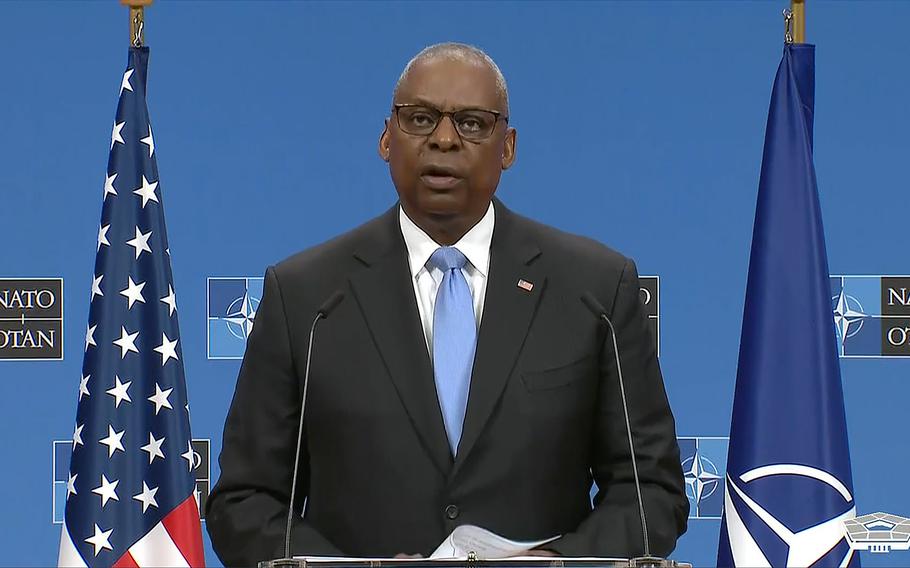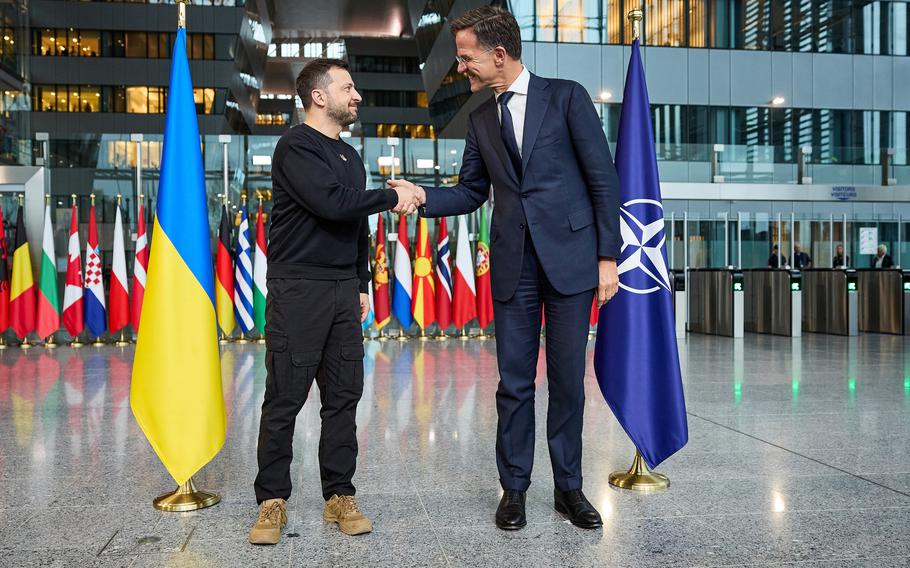
Defense Secretary Lloyd Austin speaks to reporters following a two-day NATO defense ministers meeting in Brussels, Oct. 18, 2024. (NATO)
The United States military could assist with a multinational stabilization effort in Gaza should a cease-fire be achieved there, Defense Secretary Lloyd Austin said Friday, adding that the death of Hamas’ top leader this week could mark a turning point.
“I think that’s going to require the contributions of a number of countries. Hopefully, countries in the region will step up,” Austin said. “Quite possibly there can be a part for the United States to play in that as well.”
Austin, speaking at the end of a two-day NATO defense ministers meeting in Brussels, said it was too early to know what a U.S. effort to stabilize Gaza might look like.
“The first step though is we’ve got to get to some sort of cease-fire and then we need to make sure that we’re putting the right things in place to stabilize the area and provide for some sort of security going forward,” Austin said.
The death of Yahya Sinwar, considered to be the architect of the Oct. 7, 2023, Hamas attack on Israel that killed more than 1,200 people, has heightened hopes that the ongoing war could soon draw down.
Austin said Sinwar’s death was a major achievement by Israeli forces and opens an opportunity for progress toward a cease-fire.
“Sinwar devoted his life to wrecking the chances of peace between the Israelis and the Palestinians,” Austin said. “He’s finally been brought to justice and that removes a huge obstacle.”
For now, Austin said the U.S.’s top priority is getting the remaining hostages held by Hamas released.
“They have been through hell and so have their families,” Austin said. “And the hostages should not have to suffer one more hour in captivity.”
In the meantime, U.S. forces remain in the region as a potential Israeli strike on Iran looms in retaliation for Tehran’s Oct. 2 ballistic missile attacks on Israel.
“Our forces in the region stand ready to assist in Israel’s defense, to deter aggression and to reduce the risk of all-out war,” Austin said.
In Brussels, events in Gaza were among a host of security issues discussed by allies during a gathering primarily focused on Russia’s war in Ukraine.
The defense ministers meeting was the first for new NATO Secretary-General Mark Rutte, who earlier this month replaced long-serving leader Jens Stoltenberg.

Ukrainian President Volodymyr Zelenskyy shakes hands with NATO Secretary-General Mark Rutte after arriving at the alliance's headquarters for talks, Oct. 17, 2024. (NATO)
Rutte led allies in a discussion with Ukrainian President Volodymyr Zelenskyy, who arrived at NATO headquarters Thursday to pitch his strategy for victory against Russia.
Zelenskyy’s plan hinges in part on Ukraine being granted permission by the United States and other countries to launch Western-supplied missiles into Russia.
Austin gave no sign the United States was getting closer to authorizing long-range strikes into Russia with American-made weapons. However, he credited Ukraine’s stepped-up domestic production of long-range drones, which are striking deeper inside Russia.
“How they use the capability that they’re producing is going to be their call,” Austin said.
Zelenskyy’s victory plan also calls for the rapid entry of Ukraine into the NATO alliance itself, something that Zelenskyy says could help force an end to the war with Russia within the year.
Allies, however, gave no indication that NATO membership for Ukraine could be achieved in short order.
“Obviously, we all know that Ukraine will become a member of NATO, so the question is exactly when … the invitation will take place,” Rutte said.
For allies, the obvious obstacle to having Ukraine enter NATO now is that it could make the alliance party to the war given the security pact’s principle that an attack on one demands a collective response from all.
Still, there could be workarounds. Stoltenberg, in an Oct. 4 interview with the Financial Times, said a line would need to be established that would represent what part of Ukraine would fall under the alliance’s collective defense umbrella known as Article Five.
The model could look something like Germany did during the Cold War when NATO was only protecting West Germany, Stoltenberg said.
Currently, Russia holds about 20% of Ukrainian territory.